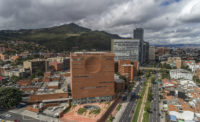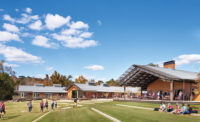Cartegena, Colombia
Cartegena, Colombia, according to a Lonely Planet entry, is the “undisputed queen of the Caribbean coast.” Its azure beaches attract droves of tourists, and its colonial-era buildings and cobblestone lanes served as muse to novelist Gabriel García Márquez. But just a 10-minute drive from this idyll, an expansive slum blankets the hill of Lomas del Peyé. Children there, isolated from city resources and unable to afford transportation to the nearest school, attend classes sporadically, if at all.
In March, the school opened with 893 students; it now accommodates 1,400 and has a capacity for 1,700. Its cafeteria dishes up nearly 1,000 lunches daily, and the facilities are accessible to the surrounding community of 34,000 people.
Initially, construction proved challenging. Basic infrastructure, including gas, electricity, and paved roads, was minimal, and building materials repeatedly disappeared from the construction site. But as the community saw the project take shape, this changed. “If the school becomes a center for the whole community, the people start thinking of the school as their own property, and they care about it,” says Lemus.
Built on the crest of the hill, the school is composed of three hexagonal concrete structures, which interlock in an Escher-like tessellation. A conical screen covers the central section like the crown of a hat, with the school spreading out around it like a brim. The screen, made from a wood composite, shades the inner courtyards, where temperatures can soar well above 100 degrees Fahrenheit. Its form can be seen throughout Lomas del Peyé and by the wealthier neighborhoods beyond. “We wanted to bring visibility to this side of the city,” says Mazzanti.
The school's 49 classrooms, organized around the perimeter of the three hexagons, are accessible from the courtyards by winding concrete ramps. The two larger volumes hold the middle- and high school classrooms; the smallest contains a preschool.
While the classrooms are made from concrete block, slatted wood walls and large windows let in plenty of daylight and airflow, and provide views to the surrounding neighborhood and sea. Three volumes, like nodes, at each of the hexagonal sub-schools house specialty classrooms— a music room, an auditorium, and an art studio—and are cantilevered over the hillside.
Crucial to the design was integrating Pies Descalzos' Open Door School Strategy—a policy by which the school also serves as a resource for the greater community. Locals can access an entrance just west of the primary student portal to use the library and to attend classes on nutrition, health, and professional development. Though the foundation donated the school to the local government, it will oversee these programs. A large athletic field sits flush against the complex for both students and the community to use for pickup games of soccer. “I like this school, because we can be proud of the community,” says Mazzanti. “It's a symbol of change in the neighborhood.”
People |
Products |










Post a comment to this article
Report Abusive Comment